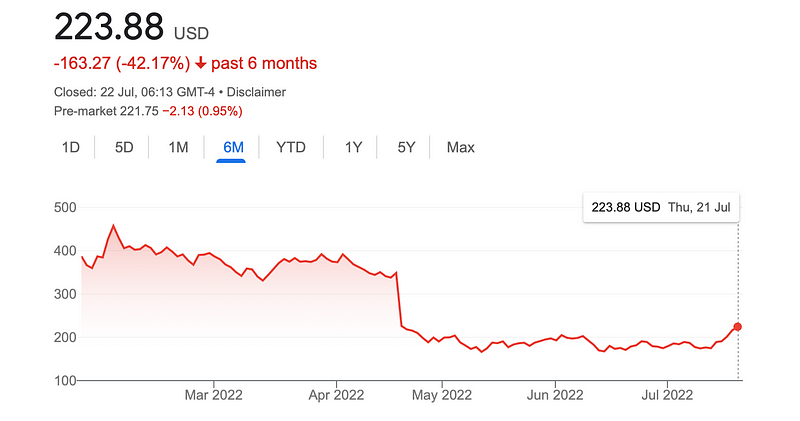Netflix Faces Major Subscriber Loss Amidst Industry Challenges
Written on
Chapter 1: The Rise and Fall of Netflix
Netflix once reigned supreme as the pioneer of streaming services, shaking up a stagnant industry that struggled to embrace technological advancements. With its first-mover advantage, it swiftly captured market share and amassed subscribers at an impressive rate. The era of binge-watching had begun, and for the first decade, Netflix adhered to the Silicon Valley mantra of prioritizing growth over profits, solidifying its position as the leading platform.
However, competitors soon recognized the opportunity to carve out their share of the subscription model, especially as the pandemic accelerated new content consumption habits. Realizing that Netflix profited from their content, these rivals shifted strategies to reclaim their intellectual property, effectively aiming to topple the streaming giant.
Initially, Netflix managed to fend off challengers like Disney+, Apple TV, and Amazon Prime, maintaining its status as the top streaming service. Yet, signs of distress emerged in 2021 when growth—an essential metric for streaming platforms—began to falter. For the first time in years, Netflix lost subscribers in the US and Canada, signaling a troubling trend that worsened into 2022. Despite expectations of gaining 2.7 million new subscribers in the first quarter, the company reported a loss of 200,000 users, marking its first decline in paid subscribers since late 2011.
The downward spiral continued.
On July 20, during its Q2 earnings call, Netflix disclosed a significant loss of nearly 1 million subscribers. Although this figure was less than the anticipated 2 million, it still indicated a worrying trajectory for the company. While the stock price briefly rebounded on the news, it remained significantly lower than its peak of $691.69 in November 2021. This marked the first occasion Netflix experienced a decline in users for two consecutive quarters.

Chapter 2: Strategies to Regain Ground
In its earnings call, Netflix projected that it would gain back 1 million subscribers in the upcoming quarter; however, this figure is nearly half of the 1.8 million anticipated by investors. Following the steep drop in stock value, Netflix has aggressively pursued strategies to recover its standing. Unfortunately, some of these measures have backfired, including multiple price increases paired with a lack of significant content hits, leaving many subscribers dissatisfied.
In a bid to curtail password sharing—which Netflix estimates affects over 100 million households—the company announced stricter policies. Additionally, it has undergone substantial layoffs, cutting 300 positions in June and 100 in May, while also slashing entire categories of programming, particularly affecting the animation sector.
In a surprising move, Netflix revealed plans to introduce an ad-supported tier, a step that many industry veterans once deemed unlikely. Though details remain sparse, this new offering is anticipated to launch later in 2023, with Microsoft assisting in its development. This partnership raises questions about Netflix's future direction and whether it will effectively stabilize the company.
Netflix Loses Almost a Million Subscribers in Three Months - BBC News - YouTube
This video explores the recent trends in Netflix's subscriber base, analyzing the implications of their significant losses and the challenges they face in the competitive streaming landscape.
The streaming market is facing a critical issue: it may not be large enough to accommodate all current players. With a finite number of households and limited time for content consumption, viewers are becoming increasingly discerning about their choices. Many are frustrated by the overwhelming amount of low-quality content flooding the market, making it essential for platforms to deliver exceptional offerings.
The ultimate solution for the streaming industry may be consolidation. It could be time for leading companies like Disney, Amazon, and Apple to absorb smaller platforms. While mergers may reduce consumer options, they could also enhance content quality by alleviating the pressure to produce excessive amounts of subpar material.
As Netflix navigates these turbulent waters, its lower stock price makes it a potential acquisition target. Analysts speculate that its partnership with Microsoft could hint at future developments, especially as Microsoft aggressively expands its gaming and cloud services.
As the landscape evolves, one thing is clear: Netflix can no longer afford to remain complacent.
Netflix Loses Nearly A Million Subscribers Last Quarter - YouTube
This video details Netflix's latest quarterly results, emphasizing the company's struggle to maintain its subscriber base amid fierce competition and changing market dynamics.
If you're interested in further insights into business and technology, consider supporting independent writers by becoming a member. Your contribution directly benefits the content creators you enjoy. Follow me on Twitter for more updates!